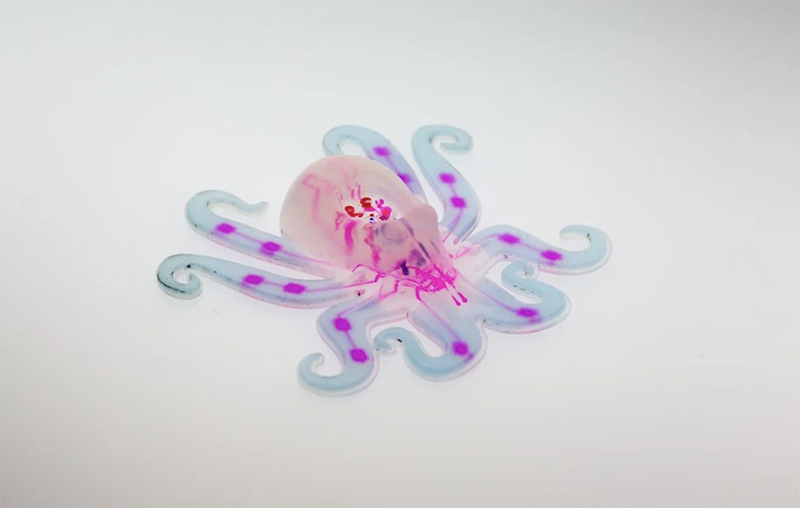When you think of robots, you might imagine those in science fiction films like Terminator , Star Trek , Star Wars , etc. However, industrial robots take many shapes and forms, including rovers, drones, surgical arms, humanoids, and even vehicles. There are several types of robots used in industries such as manufacturing, aerospace, automotive, search and rescue, medical and others.
These mechanical machines became capable of moving and performing quite advanced tasks. But robotics is not just limited to the solid state of matter. In this article, we will discuss robots that are less common and much more unique. They can deform, stretch and adapt to their environment. These shape-morphing robots are called soft robots.
What are soft robots?
Soft robots are different from conventional robots, typically made of metal and plastic, instead incorporating delicate and flexible materials. They often mimic the characteristics of soft-bodied creatures in nature, mimicking the biomechanics of worms, octopuses, or human muscles. As a result, they can deform, stretch and adapt to their environment in ways that conventional robots cannot.
Flexible robots can squeeze into tight spaces, fit on atypical surfaces and interact more safely with humans. They are widely used for medical purposes, underwater exploration, human-robot interaction, and search and rescue operations.
The first fully autonomous soft robot was “Octobot”, designed by researchers at Harvard University in 2016. It is 3D printed, with an elastomer-based body that uses hydrogen peroxide as fuel. Interestingly, the Octobot uses no electronic or rigid components.

How do soft robotics differ from conventional ones?
Soft robotics introduces a paradigm shift to the field, transcending the conventional boundaries of electronics, physics, and mechanical design. It marks the intersection of robotics and chemistry, offering a departure from the rigidity associated with typical robotic systems. And it starts with the material.
Soft robots use compatible materials such as polymers and elastomers in their construction rather than solids such as metal and plastic. Its design prioritizes flexibility, deformability and adaptability. This move away from rigid structures allows flexible robots to deform, change shape and adapt to various environments. The ability to shift is a defining characteristic of flexible robots, allowing them to navigate through complex or confined environments, or irregular spaces or surfaces, with greater ease than their rigid counterparts.
The malleability of these unique machines opens up new possibilities for applications in various fields, promising advances in robotics that go beyond the limits of conventional design principles.
With their rigid structures, mechanical robots cannot truly imitate their bioinspired counterparts. Construction typically involves machining and welding to assemble complex mechanical components, relying on motors, gears, and links for maneuverability.
In contrast, soft robots closely imitate the soft-bodied organisms that inspire them, replicating more efficient and biomimetic functionalities. They are designed using 3D printing, soft lithography and textile integration techniques.
Soft robots often employ pneumatic or hydraulic systems, shape memory alloys, and other compatible fluid and adaptive motion mechanisms. Unlike conventional robots that use wheels, treads, or legs for locomotion, soft robots move through crawling, peristaltic motion, undulation, or other nature-inspired methods in their surrounding environment.
Additionally, soft robots are inherently designed for human interaction and pose minimal risk of injury in case of accidental contact, ensuring safe coexistence with humans. There are rarely safety concerns with conventional robots operating near humans, leading to the integration of sensors for accident prevention.
This paradigm shift in design and materials heralds a new era of robotics with greater safety and biomimetic capabilities.
Conventional robots are suitable for manufacturing, assembly lines and heavy-duty operations that require precision, repeatability and endurance. Soft robots are ideal for applications that involve interactions with delicate objects, navigation through complex environments and tasks where adaptability is crucial. Such applications are often found in medicine, collaborative robotics, and search and rescue operations.
Popular Soft Robots
The first soft robot was built in 2016. Since then, several soft robots have been designed and have emerged as the field continues to advance. Here are some of the popular soft robots that have recently gained attention.
Octobô: the first soft-bodied robot, developed at Harvard University in 2016, inspired by an octopus. It operates autonomously using a combination of soft lithography, 3D printing and embedded microfluidics.
mGrip: A soft, versatile robotic gripper developed by Soft Robotics, available in several nature-inspired designs — including those inspired by the human hand or other animals. These tweezers are appropriate for delicate and irregularly shaped objects because they use compliant materials that conform to the shape of the object. They are used to grasp objects and various environments are used for robotic manipulation.
Wyss Institute Soft Robotic Exosuit: Harvard University's Wyss Institute for Biologically Inspired Engineering has developed soft exosuits, wearable devices designed to assist and augment human movement. These robots are constructed from textile materials that provide support and enhance the user's natural biomechanics. They are used in rehabilitation settings to help individuals with mobility difficulties or to improve performance in healthy individuals.
Soft robotic stingray: replicate the swimming gait of real stingrays. They are used for underwater exploration and are driven by actuators that resemble muscles.
Soft robotic catheters: used in minimally invasive medical treatments. Compared to conventional rigid catheters, they are more flexible and can pass through complex anatomical structures with less chance of causing tissue damage. The STIFF-FLOP surgical robot (flexible and learnable rigidity-controllable manipulator for surgical operations) is an example.
RoboSoftWorm: Inspired by the movement of worms, robots are typically used for search and rescue operations in confined spaces. RoboSoftWorm uses peristaltic motion to move around.
Soft Robotics Toolkit: An open source resource developed by the Harvard Biodesign Lab that provides information, designs, and tools to help researchers and engineers create their soft robotic systems.
Biohybrid soft robots: Many research teams are developing biohybrid soft robots, which combine biological cells or tissues. To perform such tasks, these robots can use organic components or muscle cells.
Soft robotic prosthetics: prosthetic devices made from soft materials, improving comfort and flexibility for users. Companies like Soft Robotics and others are working on creating adaptable and comfortable prosthetic solutions.
Soft robot for endoscopic surgery : developed for endoscopic surgery applications, allowing for more flexible and less invasive procedures.
Soft Robotic Grippers for Agriculture: Designed to allow robots to handle and harvest fruit without harming the harvest. Automated harvesting systems can benefit from this.
How are soft robots built?
Building a soft robot begins with the selection of materials, typically soft, flexible substances such as elastomers, polymers and silicone. These materials allow the robot to deform and flex, emulating the characteristics of soft-bodied organisms.
The next step involves designing the shape, structure and functionality of the robot. This process must consider the intended application, the method of movement and the tasks the robot is expected to perform. Computer-aided design (CAD) software models the flexible robot, and simulation tools analyze behavior and performance.
Once the model is finalized, specialized manufacturing techniques such as soft lithography, 3D printing or textile integration are used. Soft lithography involves casting silicone elastomers in molds to create soft, flexible structures. Some soft robots incorporate fabrics or textile-like materials to increase flexibility and introduce new features. Additive manufacturing techniques, such as 3D printing with flexible materials, facilitate the creation of complex, customized flexible robot components.
Sensors, actuators and other components are integrated into the flexible robot during manufacturing. Depending on project requirements, these robots employ pneumatic, hydraulic, or electrical actuators. Many use pneumatic or hydraulic systems to actuate and regulate movements, featuring integrated inflatable tubes or chambers filled with liquid or air to achieve controlled deformations. This comprehensive process produces flexible robots with custom shapes and functionality for a variety of applications.
Control algorithms govern the robot's movements and responses, managing various aspects such as pressure adjustment in pneumatic systems, coordination of actuator activation, and response to sensory inputs. Rigorous testing in a controlled environment evaluates actual robot performance, with design and manufacturing iterations based on test results to improve functionality, efficiency and reliability.
Depending on the design, the robot's power source may come from batteries, external sources, or energy harvesting methods.
Customization is a critical aspect of adapting soft robots to intended applications. After a design is thoroughly tested and finalized, assembly ensures proper connections and seamless integration of sensors, actuators and control systems. This meticulous process results in a flexible robot that is fully optimized and ready for its assigned tasks.
Why is soft robotics a growing field?
Soft robots represent a recent advancement in the field of robotics, offering innovation that differs from conventional approaches. This emerging technology aims to revolutionize robotics, prioritizing safety, flexibility, adaptability and accessibility.
Flexible robots are unrestricted by the rigid form and function of typical robots, allowing deployment in new and inaccessible areas. Soft robots mark a significant shift in design based on chemistry and biometrics rather than electronics and mechanics. In some cases, soft robots work without electronics and are not limited to specific kinematics or power sources. For example, Octobot obtains energy from chemical reactions. Furthermore, thanks to their flexibility and adaptability, they are promising for the development of wearable robotics.
Soft robotics excels in navigating complex and dynamic environments, pushing the limits of what was previously considered impossible.
Forms
Although it is a relatively recent development, soft robots are used in a variety of applications due to their flexibility and adaptability. Here are some examples.
Medical robotics: Useful in minimally invasive procedures, navigating delicate tissue and improving surgical precision. Soft robotic devices are suitable for exploring and performing tasks on the human body, such as endoscopic examinations and targeted drug delivery.
Human-robot collaboration: Often ideal for collaborative activities in shared workspaces because these innovative robots can interact safely and without minimal risk.
Prosthetics: These devices are made of soft materials that fit more comfortably than typical prosthetics, resembling the flexibility and range of motion of real limbs.
Clothing: Soft robotic exoskeletons can assist with physical tasks, often increasing speed and endurance, and more.
Rehabilitation: Advanced medical devices and flexible exosuits can help people recover from injuries or with limited movement. They allow for adaptive and natural mobility.
Soft Tweezers for Manufacturing: These tongs are used for delicate product handling in industrial applications. They are ideal for tasks that require a delicate touch and can imitate the contours of different objects.
Agricultural robotics: used to carry out activities such as selecting and handling fragile fruits without damaging them.
Bioinspired robotics: can imitate the movements and functions of soft-bodied creatures, taking cues from nature. This includes robotic devices designed to look like worms, octopuses and other animals.
Search and rescue: extremely useful for search and rescue missions in dangerous or difficult to reach situations. The dexterity of these soft robots allows them to maneuver around obstacles and confined areas.
Underwater exploration: As soft robots are flexible and adaptable, they are employed in underwater research. They are more adept at navigating underwater terrain than their rigid counterparts.
Space exploration: They can traverse small places and adapt to varying terrain, so soft robots have potential uses in space exploration.
Education and research: Facilitate the exploration of new materials, manufacturing methods, and control schemes by scientists and engineers that act as research platforms and instructional aids.

